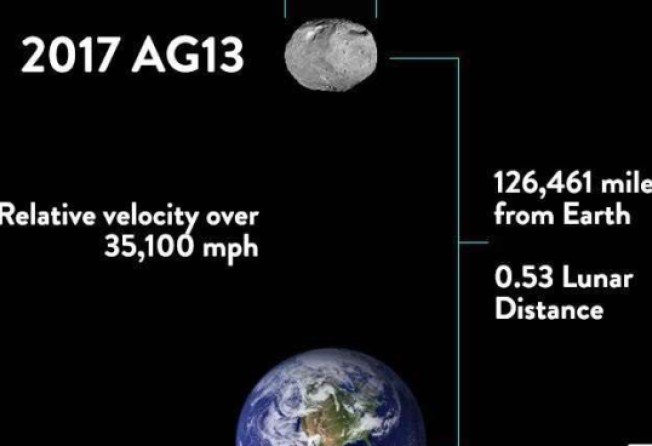We caught newly discovered asteroid 2017 AG13 as it made an extremely close approach to Earth this morning. It was closer than the Moon! pic.twitter.com/uKjWzGXmMA
— Slooh (@Slooh) January 9, 2017
An asteroid like a 10-storey building just missed Earth by only half the distance to the Moon. We barely saw it coming

On Monday, while Hongkongers were settling down to their evening meal and East Coast Americans were enjoying breakfast or cursing the morning rush hour, an asteroid as big as a 10-story building grazed Earth.
The asteroid, dubbed 2017 AG13, was discovered only Saturday by the University of Arizona's Catalina Sky Survey, according to an email from Slooh, a company that broadcasts live views of space.
The asteroid was estimated to be up to 34 metres across long and travelling at 16km/second (57,600km/h). The near-Earth object, or NEO, came within about 200,000km of Earth, or about half the distance to the moon, according to Slooh.
“This is moving very quickly, very nearby to us,” said Eric Feldman, an astronomer with Slooh, during a live broadcast of the flyby at 7.47am Eastern time on January 9. “It actually crosses the orbits of two planets, Venus and Earth.”
What would have happened if the asteroid had actually ploughed into our atmosphere?
Researchers at Purdue University, who have created a simulator called “Impact Earth!” looked into that possibility, and their results suggest it might not be as bad as it sounds.
Had a porous rock asteroid 34 metres across hit Earth at a 45-degree angle, the simulator found, it would have exploded as an airburst. The blast would have released about 700 kilotons of energy — dozens of times more powerful than the atomic bomb detonated over Hiroshima.
But since it would have occurred from a distance of about 16km high, it probably wouldn't have had much effect on the ground; if anything, a high-altitude boom may have sounded as loud as heavy traffic on the ground.
While you were hitting snooze, we nearly hit an asteroid! At 7:47 AM EST an asteroid we only first spotted Saturday gave us a wake up call. pic.twitter.com/BbAQc7e2EJ
— Slooh (@Slooh) January 9, 2017
Such strikes occur about once every 150 years, according to Purdue.
However, according to Slooh, 2017 AG3 was “roughly the same size as the asteroid that struck Chelyabinsk, Russia in 2013”, so the on-the-ground effects — including shattered windows and slightly damaged buildings — may have been similar.
“It is not that uncommon of an event, which is one of the reasons it is interesting,” said Mark Sykes, director and CEO of the Planetary Science Institute.
In fact, about 38 more “close approaches” like asteroid 2017 AG3's are expected in the month of January alone, according to Nasa’s Near Earth Object Program.
Sykes is one of the scientists behind a proposed asteroid-hunting space telescope called the Near-Earth Objects Camera, or NEOCam.
While asteroid 2017 AG3 may have slipped past NEOCam — the infrared telescope is designed to detect much larger (yet still fairly small) space rocks of roughly 140 metres in size or greater — the tentative mission is expected to discover 10 times the known NEOs of that size or bigger, compared to any previous survey of the sky.
Such objects pose a dire risk to humanity, since they can release many times the energy of thermonuclear bombs if they strike our planet.
Last week, Nasa chose for the second time not to fully fund NEOCam with US$450 million.
The space agency instead chose two other missions for future launches: Lucy, which will explore swarms of asteroids in Jupiter's orbit, and Psyche, which will fly out to and investigate the giant metallic core of a dead proto-planet.
While Nasa does intend to give NEOCam partial funding for another year, the space agency couldn't say how much or under what conditions, nor what its long-term plans are for the mission.